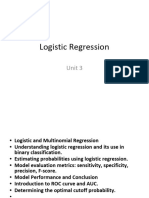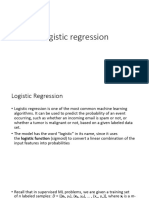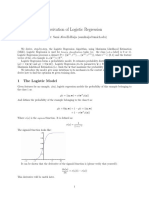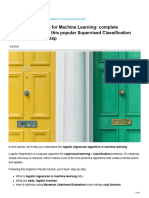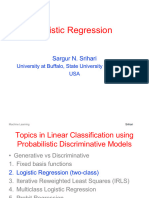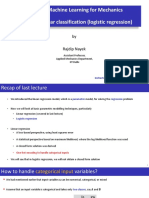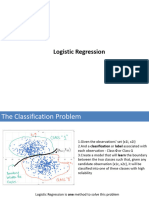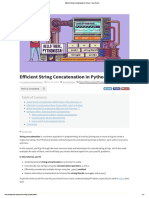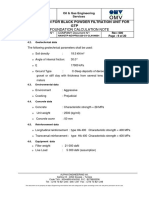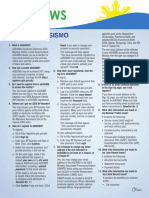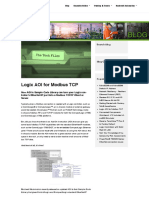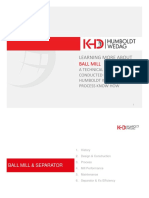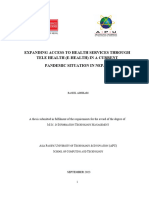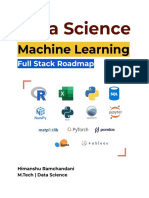Logistic Regression
Uploaded by
prabhat.oriental.pcLogistic Regression
Uploaded by
prabhat.oriental.pc5/26/25, 2:22 PM 49 Logistic Regression
Logistic Regression
Logistic Regression is a supervised machine learning algorithm that is used to predict the
probability of an event or observation outcome. It is a popular statistical method used for
binary classification problems in machine learning.
Unlike Linear Regression, which predicts continuous outcomes, Logistic Regression
predicts the probability of a binary class outcome (e.g., 0 or 1) based on one or more
predictor variables.
Sigmoid Function:
1
σ(z) =
−z
1 + e
Logistic Regression is widely used in various applications such as:
Spam detection
Credit risk analysis
Medical diagnosis
Despite its simplicity, Logistic Regression can be quite effective, especially when the
relationship between the predictor variable and the outcome is approximately linear.
However, it may not perform well with highly non-linear relationships, for which more
complex models like Decision Trees or Neural Networks might be more suitable.
In Logistic Regression, every model returns a likelihood value. The model with the
maximum likelihood is considered the better model.
Why is Maximum Likelihood a Good Parameter for Model
Evaluation?
Maximum Likelihood Estimation (MLE) is used to identify the model parameters that
make the observed data most probable. Essentially, for each data point, the model
computes the probability that it belongs to its actual class. If the probability is high, the
model is correctly predicting the class. If the probability is low, the prediction is likely
incorrect.
Thus, the model with the highest likelihood value is considered the best fit for the
data. In Logistic Regression, this corresponds to the decision boundary (or line) that
maximizes the likelihood of the observed data.
Problem: Product of Probabilities Can Cause Underflow
When calculating likelihood, we multiply several probabilities together—one for each
data point. If you have many data points, the product of these small probability values
file:///C:/Users/goura/Downloads/49 Logistic Regression.html 1/13
5/26/25, 2:22 PM 49 Logistic Regression
can become extremely small, leading to underflow (i.e., the number becomes too small
for the computer to represent).
Solution: Use Log-Likelihood
To address underflow, instead of multiplying probabilities, we take the log of the
probabilities and sum them:
Logarithms convert multiplication into addition.
This avoids underflow and simplifies computation.
However, the log of a probability (which lies between 0 and 1) is always negative. To deal
with this:
We take the negative of the log-likelihood.
Now, instead of maximizing the likelihood, we minimize the negative log-
likelihood.
This transformation allows us to use standard optimization techniques efficiently while
avoiding numerical issues.
Log Loss (Binary Cross-Entropy)
Formula:
n
1
Log Loss = − ∑ [yi ⋅ log(y
^ ) + (1 − yi ) ⋅ log(1 − y
^ )]
i i
n
i=1
Breakdown:
n : total number of samples
yi : true label for sample i
y
^
i
: predicted probability of class 1 for sample i
This is the loss function used in binary classification problems. It measures the
performance of a classification model whose output is a probability value between 0 and
1.
y
^ = σ(zi )
i
zi = β0 + β1 x1i + β2 x2i + ⋯ + βn xni
Explanation:
y
^
i
: predicted probability for the i th
data point
σ(zi ) : sigmoid function applied to z i
zi : linear combination of input features and their corresponding coefficients
file:///C:/Users/goura/Downloads/49 Logistic Regression.html 2/13
5/26/25, 2:22 PM 49 Logistic Regression
The goal is to find values of parameters β₀, β₁, β₂, ... such that the total loss L is
minimized.
Step 1: Introduction to the Sigmoid Function
When making predictions, we use the sigmoid function:
1
σ(z) =
−z
1 + e
The sigmoid function ensures that our predictions are not just hard values (0 or 1), but
probabilities between 0 and 1.
Step 2: Maximum Likelihood Concept
Using maximum likelihood:
For each training data point, we calculate the probability that it belongs to a
particular class (based on the sigmoid output).
These probabilities are multiplied across all data points.
However, multiplying many small probability values leads to very small numbers,
increasing the risk of underflow.
Step 3: Log Loss to Avoid Underflow
To prevent underflow:
We take the log of the probabilities (since log turns products into sums).
Log values of numbers between 0 and 1 are negative, so we multiply by -1 to keep
the loss positive.
The final formula works for both classes (0 and 1) in a unified way.
Logical Rule for Each Data Point
If the true label y = 1 : use -log(ŷ)
If the true label y = 0 : use -log(1 - ŷ)
This is generalized in the log loss formula.
Derivative of Sigmoid
The derivative of the sigmoid function is:
′
σ (z) = σ(z) ⋅ (1 − σ(z))
This is useful for gradient descent during model training.
file:///C:/Users/goura/Downloads/49 Logistic Regression.html 3/13
5/26/25, 2:22 PM 49 Logistic Regression
Multiclass Classification
Multiclass classification is a machine learning task that involves classifying instances into
more than two categories.
How Logistic Regression Handles Multiclass Classification:
There are two main approaches:
1. One-vs-Rest (OvR) or One-vs-All (OvA)
2. Multinomial Logistic Regression (Softmax Regression)
1. One-vs-Rest (OvR) Approach
For a classification problem with K classes, build K binary logistic regression
models.
Each model predicts the probability of one class vs all other classes.
At prediction time:
Run the input through all K models.
Select the class whose model gives the highest probability.
Disadvantage:
Not efficient for large number of classes.
2. Multinomial Logistic Regression (Softmax Regression)
This approach uses the Softmax function instead of sigmoid.
Softmax Function:
zi
e
σ(zi ) =
K zj
∑ e
j=1
Converts logits into a probability distribution across multiple classes.
Ensures that:
∑ σ(zi ) = 1
i=1
Example:
If you have logits z = [1, 2, 3] :
1 2 3
e e e
σ(1) = , σ(2) = , σ(3) =
1 2 3 4 2 3 4 2 3
e + e + e e + e + e e + e + e
file:///C:/Users/goura/Downloads/49 Logistic Regression.html 4/13
5/26/25, 2:22 PM 49 Logistic Regression
Comparison: Sigmoid vs. Softmax
Sigmoid → Used in binary classification.
Softmax → Used in multiclass classification.
Loss Function for Softmax (Cross Entropy Loss)
n K
1
L = − ∑ ∑ yik ⋅ log(y
^ )
ik
n
i=1 k=1
Where:
K = number of classes
n = number of training samples
We minimize this loss using gradient descent.
Parameter Update using Gradient Descent:
∂L
new
β = βj − η ⋅
j
∂βj
After optimization, you will have:
K weight vectors (one per class)
For 3 classes , each weight vector has 3 parameters ( β₀, β₁, β₂ )
Making Predictions:
For an input vector x , calculate logits:
(1) (1) (1)
z1 = β + β x1 + β x2
0 1 2
(2) (2) (2)
z2 = β + β x1 + β x2
0 1 2
(3) (3) (3)
z3 = β + β x1 + β x2
0 1 2
Then apply Softmax to these z values to get probabilities.
The class with the highest probability is the predicted output.
When to Use What?
Scenario Use OvR Use Softmax Regression
Classes are not mutually exclusive Yes No
Handling class imbalance Yes Less suitable
Computational efficiency is critical No Yes
file:///C:/Users/goura/Downloads/49 Logistic Regression.html 5/13
5/26/25, 2:22 PM 49 Logistic Regression
Scenario Use OvR Use Softmax Regression
Output interpretability is needed No Yes
Probability vs. Likelihood:
Probability: Given a parameter, calculate how likely a specific event is.
Likelihood: Given an event, assess how justified a parameter is.
Maximum Likelihood Estimation (MLE)
MLE is a method used to estimate the parameters of a statistical model.
What is MLE?
You have observed data.
You know the type of distribution (e.g., Bernoulli, Normal) that the data follows.
But you don’t know the parameter values of the distribution.
Your goal is to find parameter values that maximize the likelihood of the
observed data.
This process is called Maximum Likelihood Estimation (MLE).
How MLE is Used in Machine Learning
MLE is used to train parametric models (e.g., logistic regression, linear regression, Naive
Bayes, etc.).
Non-parametric models don’t have a fixed set of parameters, so MLE
doesn't apply to them.
Steps in MLE:
1. Determine the probability distribution of the target variable Y given X .
2. Select a model which is parametric in nature.
3. Initialize parameters: β₀, β₁, ..., βn
4. Define a Likelihood Function
For example, in case of Bernoulli Distribution:
y (1−y)
P (y) = p ⋅ (1 − p)
5. Find parameter values that maximize the likelihood function (or minimize the
negative log-likelihood).
file:///C:/Users/goura/Downloads/49 Logistic Regression.html 6/13
5/26/25, 2:22 PM 49 Logistic Regression
Assumptions of Logistic Regression:
1. The dependent variable is binary.
2. Observations are independent.
3. Linear relationship between independent variables and the log odds.
4. No multicollinearity among predictors.
5. Requires a large sample size.
Odds & Log Odds
Odds = Probability of event / Probability of not happening = ( \frac{P}{1 - P} )
Log Odds (also called logit):
P
logit(P ) = log( )
1 − P
Used to convert the asymmetric probability scale into a symmetric log scale.
Limitations of Logistic Regression:
1. Assumes a linear decision boundary.
2. Assumes feature independence.
3. Sensitive to outliers.
4. Requires feature scaling for optimal performance.
5. Can suffer from multicollinearity.
6. Performs poorly on imbalanced datasets.
7. Faces challenges in high-dimensional data.
8. Assumes a fixed relationship between inputs and output.
Why is it called "Logistic Regression"?
1. Regression means finding a mathematical relationship between independent
variables and the dependent variable.
2. Logistic Regression first forms a linear equation:
z = w1 x 1 + w2 x 2 + ⋯ + wn x n + b
3. Then applies the sigmoid function:
1
P (y = 1) =
−z
1 + e
4. Final output is a probability, which is then used for classification.
Although the task is classification, the name "regression" remains because
it starts by creating a regression-based relationship and transforms it.
file:///C:/Users/goura/Downloads/49 Logistic Regression.html 7/13
5/26/25, 2:22 PM 49 Logistic Regression
Summary
Logistic Regression uses the principle of regression to model probabilities.
The logistic function (sigmoid) converts a linear regression output into a
probability.
That probability is used to classify outputs into classes.
MLE is the backbone method used to train logistic regression models.
In [1]: # Import libraries
import numpy as np
import matplotlib.pyplot as plt
from sklearn.datasets import make_classification
from sklearn.linear_model import LogisticRegression
from sklearn.metrics import log_loss, accuracy_score
import seaborn as sns
sns.set(style="whitegrid")
# Generate synthetic data
X, y = make_classification(n_samples=200, n_features=2, n_redundant=0,
n_clusters_per_class=1, random_state=42)
# Visualize the data
plt.figure(figsize=(6, 4))
plt.scatter(X[:, 0], X[:, 1], c=y, cmap="bwr", edgecolor="k")
plt.title("Synthetic Binary Classification Data")
plt.xlabel("Feature 1")
plt.ylabel("Feature 2")
plt.show()
# Train logistic regression model
model = LogisticRegression()
model.fit(X, y)
# Predict probabilities and labels
y_prob = model.predict_proba(X)[:, 1]
y_pred = model.predict(X)
# Log Loss (MLE objective)
loss = log_loss(y, y_prob)
acc = accuracy_score(y, y_pred)
print(f"Log Loss: {loss:.4f}")
print(f"Accuracy: {acc:.2f}")
# Sigmoid function visualization
z = np.linspace(-10, 10, 100)
sigmoid = 1 / (1 + np.exp(-z))
plt.figure(figsize=(6, 4))
plt.plot(z, sigmoid, label="Sigmoid Curve")
plt.axhline(0.5, color='red', linestyle='--')
plt.title("Sigmoid Function")
plt.xlabel("z (Linear Combination)")
plt.ylabel("Sigmoid(z)")
plt.grid()
plt.legend()
file:///C:/Users/goura/Downloads/49 Logistic Regression.html 8/13
5/26/25, 2:22 PM 49 Logistic Regression
plt.show()
# Log loss visualization
eps = 1e-15
p = np.linspace(0.001, 0.999, 100)
loss_0 = -np.log(1 - p + eps) # True class is 0
loss_1 = -np.log(p + eps) # True class is 1
plt.figure(figsize=(6, 4))
plt.plot(p, loss_0, label="True class = 0")
plt.plot(p, loss_1, label="True class = 1")
plt.title("Log Loss vs Predicted Probability")
plt.xlabel("Predicted Probability")
plt.ylabel("Log Loss")
plt.legend()
plt.grid()
plt.show()
# Decision boundary visualization
def plot_decision_boundary(X, y, model):
h = .02 # step size in the mesh
x_min, x_max = X[:, 0].min() - .5, X[:, 0].max() + .5
y_min, y_max = X[:, 1].min() - .5, X[:, 1].max() + .5
xx, yy = np.meshgrid(np.arange(x_min, x_max, h),
np.arange(y_min, y_max, h))
Z = model.predict(np.c_[xx.ravel(), yy.ravel()])
Z = Z.reshape(xx.shape)
plt.figure(figsize=(7, 5))
plt.contourf(xx, yy, Z, alpha=0.8, cmap="bwr")
plt.scatter(X[:, 0], X[:, 1], c=y, edgecolors='k', cmap="bwr")
plt.title("Logistic Regression Decision Boundary")
plt.xlabel("Feature 1")
plt.ylabel("Feature 2")
plt.show()
plot_decision_boundary(X, y, model)
file:///C:/Users/goura/Downloads/49 Logistic Regression.html 9/13
5/26/25, 2:22 PM 49 Logistic Regression
Log Loss: 0.3665
Accuracy: 0.84
file:///C:/Users/goura/Downloads/49 Logistic Regression.html 10/13
5/26/25, 2:22 PM 49 Logistic Regression
Multiclass Logistic Regression (Softmax)
with Visualization
In [2]: # Import libraries
import numpy as np
import matplotlib.pyplot as plt
from sklearn.datasets import make_classification
from sklearn.linear_model import LogisticRegression
from sklearn.metrics import accuracy_score
import seaborn as sns
sns.set(style="whitegrid")
# Generate synthetic 3-class classification data
X, y = make_classification(n_samples=300, n_features=2, n_redundant=0,
n_classes=3, n_clusters_per_class=1, random_state=42)
# Visualize the multiclass data
plt.figure(figsize=(6, 4))
plt.scatter(X[:, 0], X[:, 1], c=y, cmap='viridis', edgecolor='k')
plt.title("Synthetic Multiclass Classification Data")
plt.xlabel("Feature 1")
plt.ylabel("Feature 2")
plt.show()
# Train Multinomial Logistic Regression
model = LogisticRegression(multi_class='multinomial', solver='lbfgs')
model.fit(X, y)
file:///C:/Users/goura/Downloads/49 Logistic Regression.html 11/13
5/26/25, 2:22 PM 49 Logistic Regression
# Predictions
y_pred = model.predict(X)
acc = accuracy_score(y, y_pred)
print(f"Accuracy: {acc:.2f}")
# Decision Boundary Plot Function
def plot_multiclass_decision_boundary(X, y, model, title="Decision Boundary"):
x_min, x_max = X[:, 0].min() - 1, X[:, 0].max() + 1
y_min, y_max = X[:, 1].min() - 1, X[:, 1].max() + 1
h = 0.02 # step size
xx, yy = np.meshgrid(np.arange(x_min, x_max, h),
np.arange(y_min, y_max, h))
Z = model.predict(np.c_[xx.ravel(), yy.ravel()])
Z = Z.reshape(xx.shape)
plt.figure(figsize=(7, 5))
plt.contourf(xx, yy, Z, cmap="viridis", alpha=0.6)
plt.scatter(X[:, 0], X[:, 1], c=y, cmap="viridis", edgecolors='k')
plt.title(title)
plt.xlabel("Feature 1")
plt.ylabel("Feature 2")
plt.show()
# Plot the decision boundary
plot_multiclass_decision_boundary(X, y, model, title="Multiclass Logistic Regres
C:\Users\goura\anaconda3\Lib\site-packages\sklearn\linear_model\_logistic.py:124
7: FutureWarning: 'multi_class' was deprecated in version 1.5 and will be removed
in 1.7. From then on, it will always use 'multinomial'. Leave it to its default v
alue to avoid this warning.
warnings.warn(
Accuracy: 0.92
file:///C:/Users/goura/Downloads/49 Logistic Regression.html 12/13
5/26/25, 2:22 PM 49 Logistic Regression
In [ ]:
file:///C:/Users/goura/Downloads/49 Logistic Regression.html 13/13
You might also like
- 11logistic Regression in Machine Learning - GeeksforGeeksNo ratings yet11logistic Regression in Machine Learning - GeeksforGeeks4 pages
- Mathematics Behind Logistic Regression Model 1598272636No ratings yetMathematics Behind Logistic Regression Model 15982726366 pages
- Machine Learning Using Optimization and Logistic Regression and Sigmoid Function - GRP 06No ratings yetMachine Learning Using Optimization and Logistic Regression and Sigmoid Function - GRP 0631 pages
- Logistic Regression For Machine Learning Complete TutorialUnderstand This Popular Supervised ClassifiNo ratings yetLogistic Regression For Machine Learning Complete TutorialUnderstand This Popular Supervised Classifi10 pages
- Credit Card Fraud Detection Using Logistic RegressionNo ratings yetCredit Card Fraud Detection Using Logistic Regression36 pages
- Binary Classification and Logistic RegressionNo ratings yetBinary Classification and Logistic Regression7 pages
- Logistic Regression in Machine LearningNo ratings yetLogistic Regression in Machine Learning10 pages
- Causality-Inspired Taxonomy For Explainable Artificial IntelligenceNo ratings yetCausality-Inspired Taxonomy For Explainable Artificial Intelligence43 pages
- NAWGTP-AEI-PF02-220-CV-CLN-00001-000 Skid Foundation Calculation Note (1) - Partie9No ratings yetNAWGTP-AEI-PF02-220-CV-CLN-00001-000 Skid Foundation Calculation Note (1) - Partie91 page
- Full Chapter of Capital Markets 5th Edition Fabozzi Ebook and TestBank Bundle EPUB DOCX PDF Download NowNo ratings yetFull Chapter of Capital Markets 5th Edition Fabozzi Ebook and TestBank Bundle EPUB DOCX PDF Download Now407 pages
- Caterpillar 825b Soil Compactor Service ManualNo ratings yetCaterpillar 825b Soil Compactor Service Manual33 pages
- John Strikwerda - Finite Difference Schemes and Partial Differential Equations100% (2)John Strikwerda - Finite Difference Schemes and Partial Differential Equations437 pages
- Lecture 3 Reprocessing - Manual - AArquiza100% (2)Lecture 3 Reprocessing - Manual - AArquiza62 pages
- Crops Diseases Detection and Solution SystemNo ratings yetCrops Diseases Detection and Solution System9 pages
- Hon EMEA14 Enhanced TPS Upgrade SolutionsNo ratings yetHon EMEA14 Enhanced TPS Upgrade Solutions22 pages
- Logix AOI For Modbus TCP - The Reynolds Company - BlogNo ratings yetLogix AOI For Modbus TCP - The Reynolds Company - Blog3 pages
- Erm4004-1 Series: Eastrising Technology Co., LimitedNo ratings yetErm4004-1 Series: Eastrising Technology Co., Limited20 pages
- Conference Schedule - Cyber Security in Telecoms 27022024161610No ratings yetConference Schedule - Cyber Security in Telecoms 270220241616101 page












